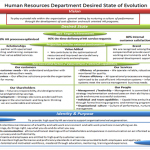How to use Performance Management tools?
In the multitude of Performance Management tools available to be deployed across organizations, managers can become confused, while trying to identify what tools to use, when and how.
To understand Performance Management tools, the first question to be asked is: what tools do I need to use at each level? Four clusters of tools are presented, in what follows, in order to answer this question, namely:
- Mission Statement, Value Statements, Vision Statement – this category of tools is used at strategic level, when establishing the corporate identity. The Mission refers to why the company exists, its role in the market. For instance, Google’s Mission is to “organize the world’s information and make it universally accessible and useful”. The Values express the company’ beliefs, with the role of influencing behaviors among employees. Innovation, integrity, community, optimism, all these are examples of values companies can adopt. The Vision shows where the company wants to be. Referring back to Google, its vision is “to make Internet advertising better – less intrusive, more effective, and more useful”.
- Value Drivers, Goals, Objectives – the second cluster of tools is still connected to the strategic level, but these instruments can only be used once the company’s identity has been established. Value drivers are characteristics of the organizational activities that reflect how the company generates value for its stakeholders. Quality is such an example of value driver, expressing the company’s emphasis on performing at high quality standard in everything it does. Goals are clustering tool for objectives, around the same theme, while objectives are a reflection of what the company has to achieve as part of its strategy. For example, the goal can be “Provide best talent for the business”, and one of the objectives under this goal can be “Optimize recruitment”.
- Metric, KPI, Target – once the company sets its objectives, it has to measure the progress towards achieving those objectives. Metrics refer to everything that can be measured: # Air temperature, # Air purity, # Employees or $ Budget. From all the metrics that are available, the company needs to choose its Key Performance Indicators (KPIs) that reflect its performance in an area relevant for its activity. % Net Promoter Score, % Employee turnover, $ EBITDA or % Budget variance are some of the most common KPIs used in business. The actual performance is then compared to the desired level of performance, the target set for each KPI.
- Programs, Initiative / Projects, Milestone – the last cluster refers to those tools that can be used at project level, to make sure objectives are actioned and money is not allocated in areas that are not aligned to the company’s strategy. Programs are clustering tools for projects, while projects / initiatives are activities with start / end dates and specific outputs to be generated. Milestones refer to main tasks/stages within a project. An example of program can be “Change Management Program”. As part of this program, an initiative can be set, such as “Succession plan roll-out”. Within the initiative, milestones can be established, such as “Complete 50% of the project by 30 June”.
Having such a granular approach towards the use of Performance Management tools helps the user understand much easier what tools need to be deployed at each level within the organization.
References:
Image Source:

Tags: Ask the Experts, Performance Management, Performance Measurement






